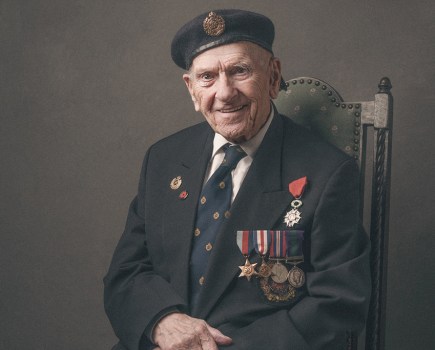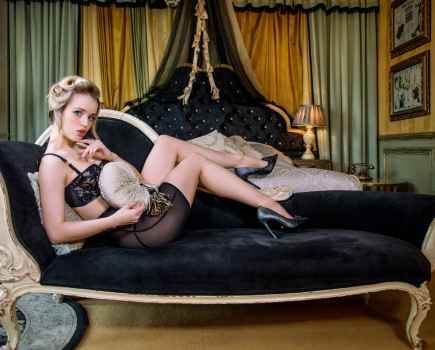There’s nothing better than spending time in the summer sun taking photos. As summertime approaches, and the hours of daylight increase, so too do the opportunities for capturing your friends and family in – excuse the pun – the best light. The benefit of outdoor portraiture is that everywhere you go is a potential studio and, with a few tips, you can make the most of every situation.
How to Shoot Outdoor Portraits – Location
 No matter where you find yourself, there will always be portrait opportunities. Every location has its own particular feature that can give an image something unique. The location doesn’t have to dictate the type of shot you take but certain places will enhance your vision. Getting your subjects to interact with the surroundings not only makes for a more interesting shot, but adds a bit of fun for everyone involved. It helps if you can choose a location where you can move around the subject to get different angles. If you can only shoot from one angle then this will limit your creativity. Just remember not to underestimate how much the background and space around the subject influences how the portrait is framed.
No matter where you find yourself, there will always be portrait opportunities. Every location has its own particular feature that can give an image something unique. The location doesn’t have to dictate the type of shot you take but certain places will enhance your vision. Getting your subjects to interact with the surroundings not only makes for a more interesting shot, but adds a bit of fun for everyone involved. It helps if you can choose a location where you can move around the subject to get different angles. If you can only shoot from one angle then this will limit your creativity. Just remember not to underestimate how much the background and space around the subject influences how the portrait is framed.
A trip to the beach is a great way to get people comfortable, and a relaxed sitter will translate into a natural photograph. The seaside can hide a wealth of discreet locations away from the crowds, from rocks formations to sand dunes. It’s worth remembering that the time of day not only affects the light but also how comfortable your sitter is. Shooting at midday not only casts harsh shadows from strong, directional light but also carries the distinct risk of sunburn. Shooting earlier or later in the day will give you a softer type of light to work with and will complement skin tones well. Sand can act as a lovely warming reflector, directing sunlight upwards; especially nice for portraits where your subject is laying down. Remember though that sand and cameras don’t mix, so take extra care when swapping lenses or accessories.
The mottling, diffusing effect of overhead trees can give you greater scope to shoot in the countryside. A blanket of leaves will soften the sunlight and using a well-shaped tree trunk will add a nice element to your composition.The contrast between a blue sky and green grass gives an excellent base on which to frame your portrait. Using a polarising filter will further enhance those striking tones as well. Look for colours in your surroundings that complement your subject and don’t be scared to use vibrant flowers to jazz up your image.
Top Tip! Use the space around the subject to emphasize size and scale.
How to Shoot Outdoor Portraits – Throwing the Background out of Focus
The most popular method of focusing all the attention on the subject is to throw the background out of focus. This is achieved by using a large aperture, such as f/2.8-4. If your camera has a portrait mode (the camera icon is usually a picture of a head), this is what your camera is doing when this is selected. Alternatively, set the camera to aperture priority and choose a wide aperture. Lenses with long focal lengths will produce a shallow depth of field but are generally more expensive. If you are on a budget, an alternative is to use the effects in an editing program, such as Photoshop. By blurring or vignetting, it is easy to focus the attention of the viewer on the subject. Examples of these are shown later in the post-production section.
How to Shoot Outdoor Portraits – Depth of Field
Depth of field is the distance in front and behind the subject that is in focus, which will vary depending on the aperture and lens that you select. The larger the aperture and the longer the focal length of the lens is, the smaller the depth of field will be. The focus falls off either side of the precise point of focus and the zone of sharpness extends 1/3 in front of the subject and 2/3 behind.
How to Shoot Outdoor Portraits – Urban Portraits
The hard edges and gritty surroundings of a built up area may not immediately appear to be too enticing for portrait work, but the texture and contrasts can work well, especially for black and white imagery. Soaring verticals, small parks and gritty backdrops can all add an extra dimension to a portrait. Look for areas without distracting backgrounds and keep an eye out for shadows cast by buildings. Try using the bustle of the city to create blurred figures either with your subject holding very still or by using flash to freeze them.
Another possibility with regard to location is to photograph the subject against a background that relates to them. In these cases, you can use a normal or wideangle lens to reflect the surroundings of the subject. Your composition and framing become very important here; ensure that the background does not overshadow or adversely affect the portrait and take care when using wideangle lenses for portraiture as the mild barrelling of these lenses can give an unflattering fish-eye effect to close-up portrait shots.
How to Shoot Outdoor Portraits – Lighting

The importance of lighting can’t be underestimated, as this is what brings your portraits to life. You can’t always choose what type of lighting you’ll get, but you can prepare for a few eventualities and make the most of opportunities that present themselves to you.
One of the most important aspects of light is its ‘quality’ – whether it’s a strong, midday light or a soft, early evening glow. This will have a vital effect on your image, making it equally important to select the right white balance to replicate the light and its effects as accurately as possible. The direction from which the light is coming and whether your subject is against a dark or light background is also important. As a general rule, if the subject is well lit and bright, it works well to contrast this with a dark background. Alternatively, if the subject is in shadow, a lighter background will place more emphasis on them.
 In any case, a soft, or even a non-directional light, will be more flattering to a subject than a harsh direct light. Shooting with the sun behind you, where it strikes your subject face on, will cause a lot of squinting – not to mention unhappy models. When the sun is behind your subject, lens flare is a risk as well as there being a harsh contrast between the bright sky and your shadowed subject. If you are working in these conditions, try to keep the sun at approximately a 45° angle to the face of the subject. This avoids the subject having to look directly into the light and squinting. Equally, when the subject is at a 90° angle to the sun, shadows will stretch right across their face. If you can’t avoid brightly lit shots, try using the sunlight as a backlight with fill-in flash from the front. You’ll soon find ways to soften the light using the area you’re in. Try looking for overhanging branches or a roof that breaks up the light. Alternatively if there are clouds in the sky wait until one moves over the sun, diffusing the light briefly.
In any case, a soft, or even a non-directional light, will be more flattering to a subject than a harsh direct light. Shooting with the sun behind you, where it strikes your subject face on, will cause a lot of squinting – not to mention unhappy models. When the sun is behind your subject, lens flare is a risk as well as there being a harsh contrast between the bright sky and your shadowed subject. If you are working in these conditions, try to keep the sun at approximately a 45° angle to the face of the subject. This avoids the subject having to look directly into the light and squinting. Equally, when the subject is at a 90° angle to the sun, shadows will stretch right across their face. If you can’t avoid brightly lit shots, try using the sunlight as a backlight with fill-in flash from the front. You’ll soon find ways to soften the light using the area you’re in. Try looking for overhanging branches or a roof that breaks up the light. Alternatively if there are clouds in the sky wait until one moves over the sun, diffusing the light briefly.
How to Shoot Outdoor Portraits – Fill-in Flash
Although flash is commonly seen as a tool for low-light situations, it can also be effectively used to fill in the shadows cast by strong directional light. It’s very easy to use – simply take your exposure reading from the background (using the evaluative mode on your camera) and your automated flash will do the rest. There are times where you may have to use the flash compensation to control the light but some camera systems compensate automatically. You can judge the strength of the flash on your subject with a quick glance on your LCD screen to see if highlights have been blown out, either by using the histogram to check an even exposure across the image, or by the blinking white areas, signalling where the image has received too much exposure. Don’t get too hung-up over whether the histogram shows a perfect graduation as sometimes blown-out highlights can eradicate what’s unnecessary to an image, placing more focus on the subject. The main thing is to make sure that your subject is correctly exposed.
How to Shoot Outdoor Portraits – Backlighting
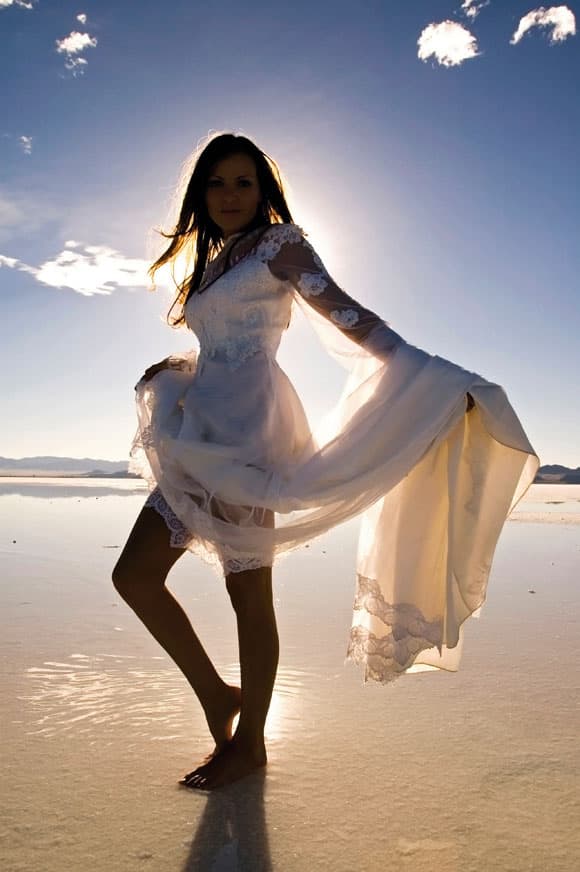 This can be an interesting way to light your subject. The key to good backlight is going to be your exposure. The camera’s exposure meter is going to be easily fooled into reading the light behind the subject. When exposed, this will leave your subject in shadow. You will need to expose for the light falling on your subject’s face to get a good exposure, using either the appropriate metering setting on your camera or a handheld light meter. A good way to give your images a 3D quality is to add fill-in flash to backlit shots, as the two light sources will combine to model the subject well and balance out the lighting problems.
This can be an interesting way to light your subject. The key to good backlight is going to be your exposure. The camera’s exposure meter is going to be easily fooled into reading the light behind the subject. When exposed, this will leave your subject in shadow. You will need to expose for the light falling on your subject’s face to get a good exposure, using either the appropriate metering setting on your camera or a handheld light meter. A good way to give your images a 3D quality is to add fill-in flash to backlit shots, as the two light sources will combine to model the subject well and balance out the lighting problems.
TIP: You may have to adjust your white balance settings as the day progresses, especially if there is a substantial shift in cloud and sun levels or if you are shooting between varied conditions, such as sun and then shade.
How to Shoot Outdoor Portraits – Reflectors
Reflectors bounce light back onto your subject, brightening up areas of shadow. They come in a range of sizes and tints (for ‘warming’ and ‘cooling’ the subject) and the great thing is that you can see what the result will be before taking the shot. Simply hold your reflector and angle it until you have the result you want. You’ll probably need someone to hold it during shooting (maybe the model themself?) or you may be able to rest it against a wall, or on the ground. Alternatively you can attach them to a lighting stand. Another device in a similar vain are diffusers. These allow sunlight to pass through but soften it and reduce its intensity.
How to Shoot Outdoor Portraits – Points of Focus
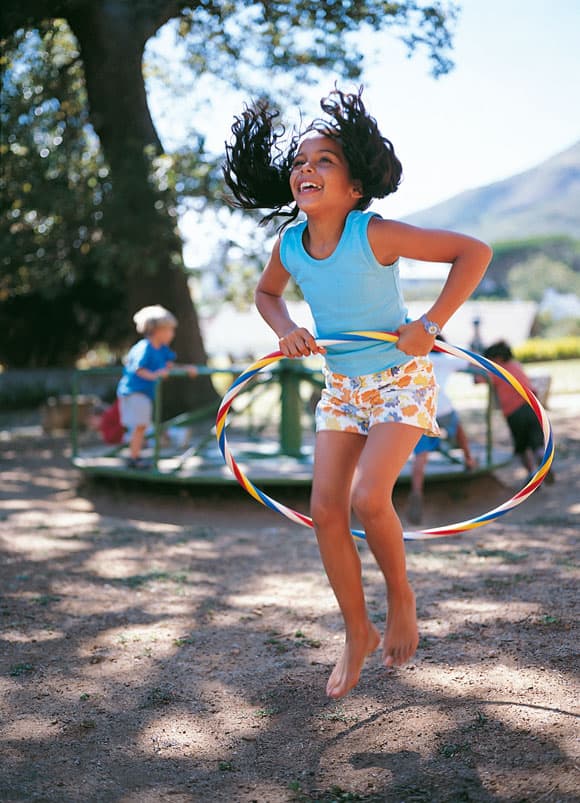 Focusing is the essential ingredient to all photography. When it comes to portraiture however, you really need to know where to focus on, especially when you are taking close-up portraits with a small depth of field.
Focusing is the essential ingredient to all photography. When it comes to portraiture however, you really need to know where to focus on, especially when you are taking close-up portraits with a small depth of field.
Select your focus mode – autofocus may be helpful but for close-up work it sometimes may be better to switch to manual focus. Remember how close your lens can focus so you’re not shooting outside of this limit.
Choose your focus area – for accuracy, switch the area of autofocus to a single point. The point does not have to sit over the area you wish to focus on as you can always focus and then recompose, but make sure that the distance between camera and subject has not changed.
Check your settings – make sure your autofocus is in one-shot mode and the camera’s drive is set to single shot.
Choose where to focus – for the majority of shots, you want the eyes to be nice and sharp as they are the feature that the viewer will look at first. Don’t be afraid to highlight different features by focusing elsewhere though.
How to Shoot Outdoor Portraits – Posing
 No matter how beautiful your location and how perfect your light, if your sitter adopts an unflattering pose you can be pretty sure that they won’t be happy with the result. Models will always look better with a well-chosen shooting angle and good posed stance.
No matter how beautiful your location and how perfect your light, if your sitter adopts an unflattering pose you can be pretty sure that they won’t be happy with the result. Models will always look better with a well-chosen shooting angle and good posed stance.
Assuming you have enough memory cards, you can shoot an unlimited number of images, editing them down to the ones you really want in post-production. Also, if shooting Raw, the control you will have over the images will greatly increase.
People often struggle to know what to do with their hands and arms in a photo. The result is that they usually look and feel uncomfortable. Rather than just letting them dangle try to incorporate them into the pose, or rest them on a horizontal surface.
A dramatic shooting angle can add real energy and intensity to a portrait. If you want dynamic shots, you need to be constantly changing your camera angles and viewpoint, looking for the best shot. Don’t be afraid to try different poses and have fun – if the subject responds well, this will come across in the images.
It’s all well to plan exactly what you expect, but don’t discount the apparent chaos of a snapshot. Many photographers thrive on this, shooting faster and capturing emotions and events as they unfold. Anticipate reactions and scenarios, and when shooting fast moving people switch the camera to a continuous shooting mode so you’re not re-focusing all the time. A zoom lens can make composition much easier, as well as sparing your legs.
Top Tip! Don’t be afraid to change your camera angles.
How to Shoot Outdoor Portraits – Putting Your Subject at Their Ease
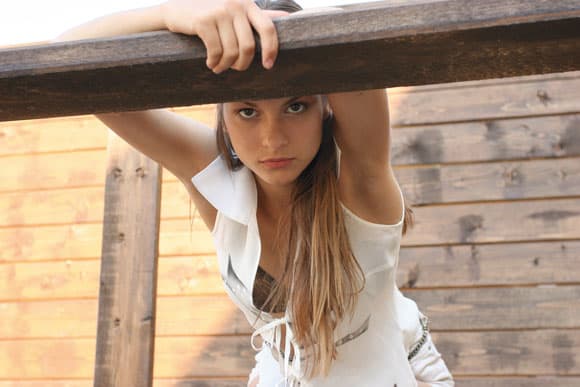 This is often something that is easily overlooked and yet in good portraiture it is one of the keys to a successful shoot.
This is often something that is easily overlooked and yet in good portraiture it is one of the keys to a successful shoot.
First impressions count, so relax the subject, even if you are nervous yourself or thinking about the technical aspects of the shoot. Getting on with the subject means they will be more patient with your requirements. Simple things like being on time, smiling, greeting, making a joke or showing an interest in your subject can help this process. You can win or lose your subject before you actually shoot a frame. Having a rough plan, writing down requirements or a sketch of the shot you are trying to achieve can all help. Take along a picture that might be an inspiration for the shot, as this can be a good reference point.
Appearing in command, even if you don’t feel confident, and stating what you want to achieve early on will help you work together as a team and also involve your subject in the process. They may have good suggestions too.
Portrait shooters often find the first 15 to 30 minutes are purely a period of getting to know the subject, and the work produced within this time is usually written off. Allocate enough time to become comfortable with the subject.
Some photographers will sit down with a drink and just chat to the subject for half an hour, so that they can allow them to relax. Physically showing them what position you want them in can also simplify explanations, speed things up and help you empathise with the subject’s point of view.
How to Shoot Outdoor Portraits – Props
Props can be useful if they have a relevance to the subject, as they can make the subject feel less self-conscious and encourage them to interact more with their surroundings. Be careful though, as there is a danger that the shoot becomes more about these items and not the subject so it’s best not to use a prop that is too much of a feature in its own right. Also, bear in mind that props can also date the shoot, which is not always good, so choose carefully.
How to Shoot Outdoor Portraits – Composition

The balance of your composition can make or break the image. When composing your shot look for lines that lead you into the image, perhaps converging in on your subject. If you frame your shot with your subject on one side, don’t forget you may have to balance out your image by including a point of interest opposite them. However, avoid the temptation to include objects for the sake of including them. Remember, any element that doesn’t add to the composition merely takes away from it.
There are many ways of framing your shots, but to make the most of your situation I would recommend a variety of angles, framing and crops. Using some basic shapes, like triangular compositions, will help lead the eye through the image and give it a natural dynamic. Standing full-length shots are good to show the whole of the subject, but can be limited in terms of framing options. They tend to leave a lot of negative space either side of the subject and for this reason are not very dynamic or lively.
There are advantages to both portrait and landscape compositions: in a portrait orientation the subject’s face can fill the frame, getting in nice and close to highlight their features as the focal point , while landscape shots give you a wider horizontal so that the background can be used more effectively, adding to the image and giving it significant depth.
One of the golden rules of composition is the rule of thirds. This rule divides a picture into an equally spaced grid of 3×3. Placing key elements on the points at which the lines intersect gives them a natural dynamic energy and creates interest.
How to Shoot Outdoor Portraits – Creative
 Once you’re confident with your portrait technique, you can start to push the boundaries a bit and release some of your creative talent. Each photo you take is, in a small way, a self-portrait, a window into how you see the world: a portrait can reveal as much about the photographer as it can the sitter. With a few tips you can take your photography to the next level, producing fantastic portraits of family and friends.
Once you’re confident with your portrait technique, you can start to push the boundaries a bit and release some of your creative talent. Each photo you take is, in a small way, a self-portrait, a window into how you see the world: a portrait can reveal as much about the photographer as it can the sitter. With a few tips you can take your photography to the next level, producing fantastic portraits of family and friends.
Consider your composition and how you can push it further. Rules are there to guide us but often the best images break those rules.
How to Shoot Outdoor Portraits – Camera Setup
Set your autofocus and drive mode to single shot, your white balance to Daylight (or Cloudy, depending on your conditions) and your ISO to 100, assuming you have good light. Now set your exposure mode to Aperture Priority and select a large aperture, such as f/2.8, in order to throw the background out of focus. Take your point of focus from the eyes of your subject by half depressing the shutter release and reframe your shot each time. If shooting without a flashgun, take your exposure from your subject. With fill-in flash, take your light reading from the background.
How to Shoot Outdoor Portraits – Using Flash Creatively

Flash isn’t just an on-camera lighting source. If you use a hotshoe-mounted flash gun, the addition of a TTL off-camera cord can allow you to move the lighting source. Strong directional lighting like this can be very effective. Some flash systems can actually control flash guns off-camera, so there is no need for cables. If you’re feeling extravagant, you can buy a dedicated wireless flash controller – such as Nikon’s SU-800 – that has the ability to control multiple flash guns in channels and groups. You can then set up flash guns to act as the main light, fill-in and background, in effect giving you a portable studio. It’s worth experimenting with the position of the flash in order to find what works and what doesn’t.
How to Shoot Outdoor Portraits – Metering
Camera metering systems can easily become confused in mixed light, so it’s worth remembering what surfaces around you represent good, mid-tone references. Both skin tone and green grass can be used to meter from, so just set your camera to spot or centre-weighted metering and take a reading. Remember to check your settings though, as the light will change over time or as a result of cloud cover.
How to Shoot Outdoor Portraits – What Gear You Need
Lenses
 Traditional portrait lenses are around 100mm – approximately 70mm focal length on most APS-C DSLRs. A standard 50mm lens is also an excellent choice as it becomes 75mm on DSLRS. Manufacturers often make a fast standard 50mm lens – with wide maximum apertures ideal for portraiture – at reasonable prices.
Traditional portrait lenses are around 100mm – approximately 70mm focal length on most APS-C DSLRs. A standard 50mm lens is also an excellent choice as it becomes 75mm on DSLRS. Manufacturers often make a fast standard 50mm lens – with wide maximum apertures ideal for portraiture – at reasonable prices.
A bonus is that the lens is compact and easier to carry around. It will involve the photographer moving around more than with a zoom lens but the results will be very sharp and accurate.
A good zoom lens can, however, be very useful, as it will help you fill the frame. Lenses with longer focal lengths produce a shallower depth of field and will therefore blur the background of your image to a greater degree.
Remote release
Setting the self-timer and running into position only for your flailing arm to be covering a relative’s face is not only frustrating but also time wasting.
A remote release means you can forgo the usual mad scramble back and also take a few shots from your position before checking. A wireless release is affordable too, with prices starting at around £15.
Flash gun
 A dedicated flash gun is a purchase most photographers will make soon after buying their camera. With outdoor photography the light will be constantly changing and you will need to adapt to the circumstances.
A dedicated flash gun is a purchase most photographers will make soon after buying their camera. With outdoor photography the light will be constantly changing and you will need to adapt to the circumstances.
A separate flash gun gives you more power than the onboard flash and also doesn’t drain the camera’s battery. They can range from affordable, such as Nikon’s entry level SB-400, to Nikon’s top-of-the-range professional SB-800, with the Nikon SB-600 in between.
Reflector
A reflector is a cheap way of using available light to its full potential and they come in a variety of colours depending on the result you need. Typically it will have two different finishes – one on either side – so you have the added option of altering the light bounced from it.
Lastolite is one of the leading brands in the market and makes reflectors ranging from 30cm up to a giant 1.8m by 1.2m. They are flexible and portable and come in a wide range of finishes.
Accessories
 Spare batteries for your flash and camera are essential. It can be very disappointing to travel to a location only to find one of these lets you down and you have wasted your journey.
Spare batteries for your flash and camera are essential. It can be very disappointing to travel to a location only to find one of these lets you down and you have wasted your journey.
Another useful item is a small stepladder, as being able to shoot from high angles is a real benefit at times.
Spare memory cards are one thing you shouldn’t be without as there are few things more irritating than to find that you have run out of room on your card. It will also eradicate the need to delete images from the card you are working with while you are shooting.




